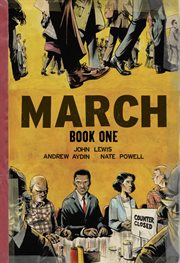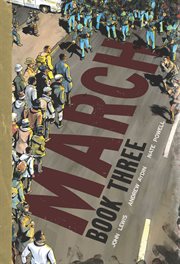Review by Booklist Review
Lewis, Aydin, and Powell's stirring March trilogy continues in this first installment in a follow-up series tracing Lewis' life and career after the passing of the Voting Rights Act of 1965. Lewis is dedicated to but exhausted by his role as chairman of SNCC, and after the success of their earlier actions, the committee is wondering what to do next. Divisions hinted at in the March books bear fruit here, as a schism develops between factions in favor of more direct action and Lewis' commitment to nonviolence, especially as protests against the draft escalate. This is a wordy graphic novel, with abundant speech balloons and voice-overs offering insight into Lewis' motivations, but such a complicated moment in civil rights history deserves this kind of exploration. Particularly poignant is the focus on the limitations of the Voting Rights Act, which did nothing to stop violence directed at Black people or end systemic racism--facts all too relevant to today's current events. Fury balances those words with meaningful scenes, and her faces are expressive and distinct, helping with this volume's lengthy roster of characters. This is a fantastic choice for classrooms, though readers should be familiar with the March trilogy before diving in. Apart from the educational components, this will speak powerfully to anyone trying to make sense of their own values in the face of wider movements and calls to action. HIGH-DEMAND BACKSTORY: The March trilogy are some of the most recognizable graphic novels of the past few decades, thanks to scores of awards, so anticipate a lengthy hold list.
From Booklist, Copyright (c) American Library Association. Used with permission.
Review by Publisher's Weekly Review
This worthy successor to the late Congressman Lewis's March graphic memoir trilogy picks up in the civil rights leader's life during the 1960s counterculture revolution. The narrative opens where March ended, with the hard-fought passage of the Civil Rights Act. But with these freedoms come fresh challenges and old threats that refuse to die. The Watts Riot breaks out just five days after the signing of the Voting Rights Act, foreshadowing the fraught period to come. As head of the Student Nonviolent Coordinating Committee, Lewis struggles to carry on the peace-based activism of his friend and mentor, Martin Luther King Jr., in the face of waves of white supremacist violence. As militant young Black activists take up the chant of "Black Power!" and ideological divisions tear the SNCC apart, Lewis and his colleague navigate sticky issues like the Vietnam War draft ("Where is the draft for the freedom fight in the United States?") and the Black separatist movement. "Is America ready to share its abundance with people of color?" Lewis wonders. At the same time, civil rights organizers such as Julian Bond and Marion Barry overcome enormous odds and violent opposition to win elected office, giving the still-young Lewis a glimpse of hope for his own political future. Newcomer Fury takes over capably from March's artist Powell (who assists on this volume), drawing in a similar fluid, softly shaded style that provides continuity while guiding readers into complex issues. This living history gives faces and voices to the legends of the civil rights era and connects their struggles to the present; the police brutality, voter suppression tactics, and segregationist politics of the 1960s are not so different from those Lewis was still making "good trouble" against at the time of his death in 2020. Lewis's stunning American story and legacy lives on in these pages. Agent: Jeff Posternak, the Wylie Agency. (Aug.)
(c) Copyright PWxyz, LLC. All rights reserved
Review by Library Journal Review
A fourth illustrated civil rights history/memoir by the late congressman John Lewis and the team behind "March," his National Book Award-winning trilogy of graphic novels. The present volume (most pages were finished prior to Lewis's death in 2020) picks up after March: Book Three, in the turbulent era directly following the signing of the Voting Rights Act in 1965. It finds a 25-year-old Lewis struggling to retain his chairmanship in the Student Nonviolent Coordinating Committee (SNCC), rife with conflict. Members can't agree on a response to the surge of white supremacist attacks nationwide, or the escalating death toll of the Vietnam War; some are questioning the effectiveness of nonviolence. Lewis's plan to endorse Democratic Party candidates for public office creates further schisms within the SNCC; so does the Georgia state legislature's refusal to seat an elected representative who had endorsed the SNCC's position on Vietnam. When Lewis loses the SNCC chairmanship to Stokely Carmichael, he begins to despair at having worked so hard only to find himself washed-up at 26. He soon regains his determination to continue the civil rights struggle--this time from within the system, by running for office. VERDICT An unsentimental chronicle of a difficult period in United States history and in Lewis's life. Lewis makes clear that creating meaningful change is a contentious, complicated, and, most importantly, continuous process.
(c) Copyright Library Journals LLC, a wholly owned subsidiary of Media Source, Inc. No redistribution permitted.
Review by School Library Journal Review
Gr 8 Up--In this follow-up to the acclaimed "March" trilogy, which picks up right after the signing of the Voting Rights Act of 1965, Lewis and the Student Non-violent Coordinating Committee (SNCC) face one challenge after another. White supremacists, including law enforcement, resist social change and calls for integration. White violence and domestic terrorism target churches, traffic stops, voting booths, and public demonstrations. Apartheid in South Africa and the Vietnam War, along with the draft, add new frontiers to a progressive movement that watches one cold-blooded killing after another take place in the United States without justice. Increased pressure and lackluster results lead to infighting among SNCC's membership, who work to make change from a place of love but become increasingly frustrated and jaded. Lewis is but one committed figure here, as many dedicated Black and white members of SNCC are depicted, including those who opposed Lewis's leadership and continuous calls for integration and nonviolence. Fury and Powell's artwork captures various states of helplessness, from losing an election to staring down the barrel of a gun, while also conveying the determination and anger that Lewis and his peers summoned to keep from quitting. Extensive biographical, reference, and artistic notes in the back matter will illuminate casual and student readers alike. VERDICT Just as powerful as the "March" trilogy, this paean to "nonviolent soldiers" is principled, tragic, and stirring.--Thomas Maluck, Richland Lib., SC
(c) Copyright Library Journals LLC, a wholly owned subsidiary of Media Source, Inc. No redistribution permitted.
Review by Horn Book Review
The story begun in the March graphic memoirs (rev. 1/14, 5/15, and 9/16) -- events of the civil rights movement as seen through the eyes of young activist (and later longtime Congress member) John Lewis -- continues in this first volume of a projected new series. It picks up after the Voting Rights Act of 1965, as Lewis questions his own effectiveness as SNCC (Student Nonviolent Coordinating Committee) chairperson. But Lewis's personal story is mostly a springboard to larger events. Depictions of efforts by segregationists to close or move polling stations; the unpunished 1966 murder of young Black man Samuel Younge Jr.; and the prevention of Julian Bond's being seated in the Georgia General Assembly show how white supremacists and segregationists were emboldened to maintain existing power structures. Taking over most art duties from March illustrator Powell (who illustrates the pages leading up to the title page), Fury renders emotionally devastating, often violent events and quieter moments with equal finesse. Her grayscale art is reminiscent of Powell's, but with cleaner-lined, less stylized figures. Extensive back matter includes biographical information on dozens of individuals, meticulous source notes, and additional background on both the civil rights movement and the book's creation. Most of the finished pages were completed before Lewis's death in 2020; plans are in progress for the series to continue with additional material he and Aydin worked on together. As informative and essential an addition to the nonfiction comic canon as its much-lauded predecessors. Eric Carpenter September/October 2021 p.121(c) Copyright 2021. The Horn Book, Inc., a wholly owned subsidiary of Media Source, Inc. No redistribution permitted.
(c) Copyright The Horn Book, Inc., a wholly owned subsidiary of Media Source, Inc. No redistribution permitted.
Review by Kirkus Book Review
A companion to the award-winning, groundbreaking March graphic memoir series, this is the final work completed by Congressman Lewis before his death in July 2020. What happened after the 1965 marches in Selma? Although segregation was no longer legal, America had not yet embraced true equality. Shortly after the passage of the Voting Rights Act of 1965, a six-day uprising took place in the neighborhood of Watts in Los Angeles, with similar protests in Chicago. (Readers will likely note parallels between these events and the 2020 protests.) With welcome frankness, Lewis recounts his tenure as chairman of the Student Nonviolent Coordinating Committee, being at odds with organizations like the NAACP and the Urban League, the repercussions of SNCC's public stances against the Vietnam War and apartheid in South Africa, and the generational divide within SNCC. Lewis questioned his own effectiveness as a leader (and was eventually ousted), but his focus throughout the book is on the hundreds of unsung individuals who undertook the sometimes-deadly work that Black voter registration and other grassroots social justice efforts demanded. Compelling art perfectly captures the tension and terror of these troubled times, as told from Lewis' memory with the backing of scholarly works and research. An intimate, powerfully revealing look at a crucial, complex time, through the eyes of a true American hero. (biographies, notes, sources, from the artist, about the authors, co-author's note) (Graphic memoir. 12-adult) Copyright (c) Kirkus Reviews, used with permission.
Copyright (c) Kirkus Reviews, used with permission.


